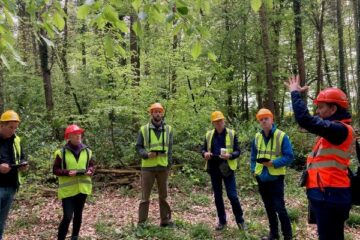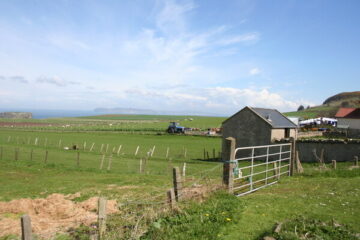During a recent visit to the farm forest site of Ivor Clegg outside Portlaoise, organised by the Irish Bioenergy Association (IrBEA), Minister Pippa Hackett saw at first hand the economic and environmental benefits of early thinning of broadleaves and conifers to supply energy markets.
Minister of State, Senator Pippa Hackett said about the benefits of early thinning, “on this site, we have a wonderful example of a multi-species forest. Ivor Clegg, the forest owner, through hands on management, has promoted biodiversity while maximising the production of high quality timber. The early thinning operations have provided an early financial return in the form of sustainable woodchip fuel and some sawnwood, and at the same time have opened up the forest to allow more light in which brings many benefits. Sustainable forest management practices increase the economic return to the forest owner and enhance the quality of the final timber products produced.”
The Department of Agriculture, Food and the Marine roundwood production forecast incudes an estimated increase in forest bioenergy availability of over 1 million cubic metres per year over the coming decade, essentially a doubling on current output. This is reflected in the Climate Action Plan 2021.
Sean Finan, CEO of the Irish Bioenergy Association said, “this increased availability of biomass material alone could provide heating for up to 90,000 homes, and over 600 business/commercial premises. These increases could be mediated through a number of measures, such as the Support Scheme for Renewable Heat (SSRH) and, for example, a rolled-out programme of district heating in larger towns and urban centres, which merits consideration. Overall estimated greenhouse gas savings per annum are 500,000 tonnes of CO2 from the additional biomass, depending on harvesting technologies employed, end use efficiencies and type of fossil fuel displaced. Further information can be obtained from the Renewable Energy Ireland ‘40×30’ report.”
The Wood Fuel Quality Assurance scheme (WFQA) members provides an outlet for thinning material for the production of certified renewable wood fuels.
Noel Gavigan, WFQA Administrator said, “forest owners and forestry contractors through sustainable forest management practices, produce renewable fuels such as firewood, wood chip, wood pellets, and wood briquettes. These fuels are certified to ISO and EU standards through the WFQA scheme. Wood fuels allow home owners and businesses to move away from fossil fuel, fully decarbonising their heating systems, and ensure that the money they spend on energy stays in the local economy. It’s the essence of building and developing the rural economy.”
Kenneth Worrell, Worrell Harvesting said, “the thinning system and timelines utilised on this site, allows much greater volumes of biomass recovery at first thinning. Early thinning, starting at age 16, when tree heights are in the 10-12m range allows us to take out smaller and poorly shaped trees. The required amount of brash is left on the ground to eliminate rutting and the rest of the tree is removed to roadside. At this point, any sawmill product is extracted and hauled to the sawmill.”
“This is controlled by Worrell Harvesting through a live traceability system called LOG WATCH. All of the trees including the tops and branches are harvested and left in the wood before being removed to road side after the needles have fallen off. This material is stacked for further drying before being chipped and removed for energy. This process doubles the amount of biomass produced per hectare. This makes the operation more economically attractive to the grower and buyer. Harvesting the first thinning earlier stabilized the crop, shortens the growing cycle and enhances the quality of the final crop. This system has many advantages as tops and branches would normally be left in the forest as residues, to decay releasing CO2”



